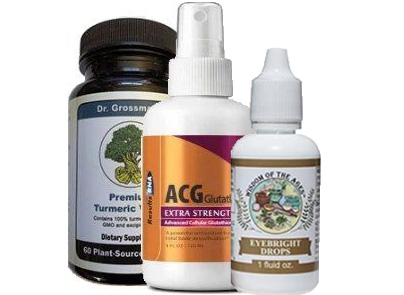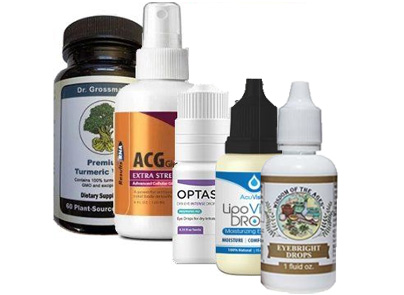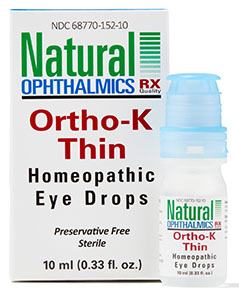Corneal Disease
Protecting the eye Self help Corneal Conditions
The cornea is a transparent surface at the front of the eye protecting the eye from foreign objects and absorbing nutrients and oxygen. It contains no blood vessels, unlike other tissues of the body and so special layers of tissue perform functions of delivering oxygen and nutrition in a unique way. Not only does the cornea protect the eye, but the alignment of protein fibers within its structure is precisely oriented so that light can pass through unobstructed, and already partially focused - providing from 65% to 75% of the focusing capacity of the eye.
Vitamins
& Supplements
Not sure which to get?For help call us at 845.475.4158
Complete Product List
Discount Packages Corneal Support Package 1 Corneal Support Package 1Nutrients for corneal support.  Corneal Support Package 2 Corneal Support Package 2Nutrients to support the cornea and overall eye health. |
Essential Ortho K Thin (Daytime) Homeopathic Eye Drops 10ml per bottle Ortho K Thin (Daytime) Homeopathic Eye Drops 10ml per bottleHelpful for dry eyes and general corneal support and healing. |
| Important MSM (Methyl sulfonyl methane) Capsules 120 Capsules Castor Oil (organic) Eyedrops 2oz |
Call us for detailed information
Nutrients for the Cornea
- Homeopathic formulations help relieve irritation due to dryness.
- Taurine supports the regeneration and elimination of worn out tissue.
- Glutathione and other antioxidants help stop free radical damage and support formation of enzymes in eye tissue.
- Juicing helps delivery food based nutrients to your digestive system efficiently. See our juicing/smoothie recipe to help support the health of the cornea.
Structure & Function
The cornea can be scratched easily but also heals itself unusually quickly - especially for minor, surface scratches - when healthy cells simply "slide over" to cover the damaged tissue.
The overall function of the cornea is to provide an outer layer of protection to the interior of the eye and absorb oxygen and nutrients.
The cornea is made up several layers of tissue, some only one cell thick.

- Epithelium: This is the outer layer of the eye is about five cells deep. It is full of tiny nerve endings giving the tissue tremendous
sensitivity to pain. It performs two important roles.
It protects the lens and the interior of the eye from water, dust, eye lashes, and any other foreign material that damage the eye.
It absorbs nutrients and oxygen directly from outside the body and makes it possible for eye drops to provide nutrition or supportive ingredients directly. - Bowman's Layer: This layer is made up of collagen, the same elongated fibers that are found in skin, tendons and ligaments. It helps to maintain the shape of the cornea.
- Dua's Layer: Discovered in 2014, the Dua's Layer is a very thin layer of collagen which is impervious to air. The discovery will make a difference in the process of posterior corneal surgery.
- Stroma: The stroma is a thick layer made up of water, layers of protein fibers (that support shape, elasticity and strength) and cells that provide nourishment to this layer.
- Descemet's Membrane: This layer provides an essential surface for generation of endothelium cells.
- Endothelium: Only one cell thick this thin layer pumps excess water out of the stroma keeping it slightly dehydrated and therefore, transparent. It allows nutrients to leak into the stroma but pumps out excess liquid.
Conditions of the Cornea
Allergies
One of the more common conditions to affect the cornea and eye comfort are those caused by various allergies - dust, pollen, animal hair and dander, mold, cosmetics. The cornea may become red and inflammed and tearing can occur. Homeopathic remedies for sensitivity to allergens can be very effective. Learn more about allergies and sensitivities and natural solutions for sore, irritated, red eyes.
Conjunctivitis
Pinkeye or conjunctivitis is an infection of the moist surfaces of the eye that can harm your vision if it gets into the cornea. Conjunctivitis normally results in red, irritated eyes that last for several days to a week. It can be caused by bacteria, viruses or allergies. Learn more about treatment of conjunctivitis.
Corneal Infection
Like conjunctivitis, eye infections such as blepharitis (inflammed eyelids) and eye styes (inflammed eye lash follicle) can be serious because if the infection spreads into the cornea vision may be damaged. An infection to the cornea may also result from contamination from foreign objects. Infections resulting from contact lens use can be the most serious complication. Corneal infections can lead to scarring of the cornea, limiting vision and possibly requiring a corneal transplant.
Dry Eye
Dry eye is the most common complaint told to eye doctors, especially in women after menopause. It can be caused by allergies, dry air, long hours on the computer (when blinking is reduced), use of some drugs. Learn more about what causes and how to treat dry eyes naturally. Homeopathic eye drops are very effective in treating dry eye.
Fuchs' Dystrophy
Fuchs' is a disease of the cornea that develops slowly and severely damages vision. It degrades the inner endothelium because the Descemet's membrane is damaged and cysts develop in the outer epithelium layer. Because the inner endothelium is essential to regulate proper stroma hydration, if it isn't functioning correctly the cornea layers swell and distort vision - eventually causing severe vision damage as well as pain.
Learn more about Fuchs' Dystrophy.
Keratoconus
Keratoconus, caused by thinning of the cornea, results in the cornea bulging outward. Similarly to Fuchs, the endothelium layer is damaged permitting water buildup. Additionally, the Dua layer may develop tears, also permitting fluid buildup, and the Bowman's Layer may deteriorate.
Learn more about keratoconus.
Lattice Dystrophy
The protein fibers in the stroma are normally perfectly aligned so as to permit the focused passage of light into the eye. In this condition however, abnormal protein fibers accumulate in the middle and front of the stroma and sometimes under the epithelium layer. To the eye doctor, they look like a latticework. The condition may develop to an extent requiring a corneal transplant.
Pterygium
A pterygium is a cream color growth at the edge of the cornea near the nose. They can be removed by surgery but usually return. They are usually caused by exposure to hot, windy environments. They are not dangerous but can be uncomfortable. Learn more about pterygium.
Limbal Stem Cell Deficiency
Limbal stem cells, also known as corneal epithelial stem cells, are those stem cells found at the border of the center cornea and the white of the eye. Deficiency has been known to arise due to acute causes like thermal, radiation, or chemical trauma, but also appears where other chronic conditions occur such as inflammatory eye conditions, and use of long term contact lenses and surgery for glaucoma and cataracts. Inflammatory eye conditions include dry eye, Sjogren's, and vernal keratoconjunctivitis.
Other corneal conditions
There are other conditions that affect the body or skin which can develop in the cornea such as Stevens-Johnson Syndrome, ocular herpes, and shingles.
 info@naturaleyecare.com
info@naturaleyecare.com



 Home
Home



 Vision
Vision Vision
Vision



 Health
Health Health
Health Research/Services
Research/Services Pets
Pets About/Contact
About/Contact


